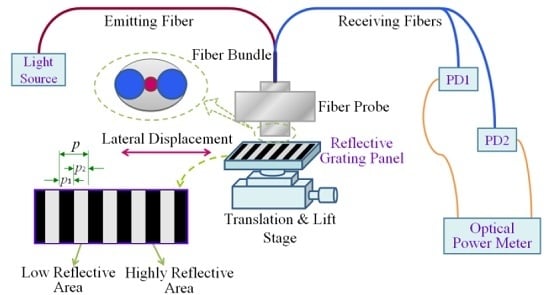An Optical Fiber Lateral Displacement Measurement Method and Experiments Based on Reflective Grating Panel
Abstract
:1. Introduction
2. Measurement Method and System for Lateral Displacement
2.1. Working Principle
2.2. Preliminary Theoretical Derivation
3. Simulation Calculation
3.1. Optical Modeling
3.2. Relationship between Fiber-Grating Distance and Received Optical Power
3.3. Relationship between Lateral Displacement and Received Optical Power
4. Signal Subdivision and Error Analysis
5. Experimental Results and Discussion
5.1. Self-Made Fiber Optic Grating Ruler and Signal Processing
5.2. Displacement Measurement Experiments
5.3. Large Range Measurement Experiments
5.4. Temperature Test
6. Conclusions
Acknowledgments
Author Contributions
Conflicts of Interest
References
- Andrew, J.F. A review of nanometer resolution position sensors: Operation and performance. Sens. Actuators A Phys. 2013, 190, 106–126. [Google Scholar]
- Li, H.; Ren, L.; Jia, Z.; Yi, T.; Li, D. State-of-the-art in structural health monitoring of large and complex civil infrastructures. J. Civ. Struct. Health Monit. 2015. [Google Scholar] [CrossRef]
- Poeggel, S.; Tosi, D.; Duraibabu, D.; Leen, G.; McGrath, D.; Lewis, E. Optical Fibre Pressure Sensors in Medical Applications. Sensors 2015, 15, 17115–17148. [Google Scholar] [CrossRef] [PubMed]
- Baxter, L.K. Capacitive Sensors: Design and Applications; IEEE Press: New York, NY, USA, 1997. [Google Scholar]
- Guo, T.; Wang, S.; Dorantes-Gonzalez, D.J.; Chen, J.; Fu, X.; Hu, X. Development of a hybrid atomic force microscopic measurement system combined with white light scanning interferometry. Sensors 2011, 12, 175–188. [Google Scholar] [CrossRef] [PubMed]
- Fericean, S.; Droxler, R. New noncontacting inductive analog proximity and inductive linear displacement sensors for industrial automation. IEEE Sens. J. 2007, 7, 1538–1545. [Google Scholar] [CrossRef]
- Nabavi, M.R.; Nihtianov, S.N. Design strategies for eddy-current displacement sensor systems: Review and recommendations. IEEE Sens. J. 2012, 12, 3346–3355. [Google Scholar] [CrossRef]
- Proksch, R.; Cleveland, J.; Bocek, D. Linear Variable Differential Transformers for High Precision Position Measurements. U.S. Patent 7262592, 28 August 2007. [Google Scholar]
- FASTRACK. High-Accuracy Linear Encoder Scale System. Data Sheet l-9517-9356-01-b. Available online: www.renishaw.com (accessed on 20 February 2016).
- Lee, J.; Chen, H.; Hsu, C.; Wu, C. Optical heterodyne grating interferometry for displacement measurement with subnanometric resolution. Sens. Actuators A Phys. 2007, 137, 185–191. [Google Scholar] [CrossRef]
- Moro, E.A.; Todd, M.D.; Puckett, A.D. Using a validated transmission model for the optimization of bundled fiber optic displacement sensors. Appl. Opt. 2011, 50, 6526–6535. [Google Scholar] [CrossRef] [PubMed]
- Cusano, A.; Cutolo, A.; Giordano, M. Fiber Bragg gratings evanescent wave sensors: A view back and recent advancements. Sensors 2008, 21, 113–152. [Google Scholar]
- Ma, Y.; Wang, C.; Yang, Y. High resolution and wide scale fiber Bragg grating sensor interrogation system. Opt. Laser Technol. 2013, 50, 107–111. [Google Scholar] [CrossRef]
- Ho, S.C.M.; Ren, L.; Li, H.; Song, G. Dynamic fiber Bragg grating sensing method. Smart Mater. Struct. 2016, 25, 025028. [Google Scholar] [CrossRef]
- Chang, Y.; Yen, C.; Wu, Y.; Cheng, H. Using a Fiber Loop and Fiber Bragg Grating as a Fiber Optic Sensor to Simultaneously Measure Temperature and Displacement. Sensors 2013, 13, 6542–6551. [Google Scholar] [CrossRef] [PubMed]
- Zhang, Q.; Ianno, N.; Han, M. Fiber-Optic Refractometer Based on an Etched High-Q π-Phase-Shifted Fiber-Bragg-Grating. Sensors 2013, 13, 8827–8834. [Google Scholar] [CrossRef] [PubMed]
- Kampmann, P.; Kirchner, F. Integration of Fiber-Optic Sensor Arrays into a Multi-Modal Tactile Sensor Processing System for Robotic End-Effectors. Sensors 2014, 14, 6854–6876. [Google Scholar] [CrossRef] [PubMed]
- Allen, G.; Sun, K.; Byer, R. Fiber-coupled, Littrow-grating cavity displacement sensor. Opt. Lett. 2010, 35, 1260–1262. [Google Scholar] [CrossRef] [PubMed]
- Harun, S.W.; Yasin, M.; Ahmad, H. Micro-displacement sensor with multimode fused coupler and concave mirror. Laser Phys. 2011, 21, 729–732. [Google Scholar] [CrossRef]
- Golnabi, H. Design and operation of different optical fiber sensors for displacement measurements. Rev. Sci. Instrum. 1999, 70, 2875–2879. [Google Scholar] [CrossRef]
- Hu, X.; Li, Y.; Chen, Y. Transmissive fiber optical displacement sensor using cutting plate. Microw. Opt. Technol. Lett. 2012, 54, 446–448. [Google Scholar] [CrossRef]
- Yasin, M.; Harun, S.W.; Fawzi, W.A. Lateral and axial displacements measurement using fiber optic sensor based on beam-through technique. Microw. Opt. Technol. Lett. 2009, 51, 2038–2040. [Google Scholar] [CrossRef]
- Golnabi, H.; Azimi, P. Design and operation of a double-fiber displacement sensor. Opt. Commun. 2008, 281, 614–620. [Google Scholar] [CrossRef]
- Shen, W.; Wu, X.; Meng, H. Long distance fiber-optic displacement sensor based on fiber collimator. Rev. Sci. Instrum. 2010, 81. [Google Scholar] [CrossRef] [PubMed]
- Choi, S.; Kim, Y.; Song, M.; Pan, J. A Self-Referencing Intensity-Based Fiber Optic Sensor with Multipoint Sensing Characteristics. Sensors 2014, 14, 12803–12815. [Google Scholar] [CrossRef] [PubMed]
- Martinez-Rios, A.; Monzon-Hernandez, D.; Torres-Gomez, I.; Salceda-Delgado, G. An Intrinsic Fiber-Optic Single Loop Micro-Displacement Sensor. Sensors 2012, 12, 415–428. [Google Scholar] [CrossRef] [PubMed]
- Zawawi, M.A.; O’Keeffe, S.; Lewis, E. Plastic optical fibre sensor for spine bending monitoring with power fluctuation compensation. Sensors 2013, 13, 14466–14483. [Google Scholar] [CrossRef] [PubMed]
- Harun, S.W.; Yang, H.Z.; Arof, H.; Ahmad, H. Theoretical and experimental studies on coupler base fiber optic displacement sensor with concave mirror. Optik 2012, 123, 2105–2108. [Google Scholar] [CrossRef]
- Pinto, A.M.R.; Baptista, J.M.; Santos, J.L.; Lopez-Amo, M.; Frazão, O. Micro-displacement sensor based on a hollow-core photonic crystal fiber. Sensors 2012, 12, 17497–17503. [Google Scholar] [CrossRef] [PubMed]
- Islam, M.; Ali, M.; Lai, M.; Lim, K.; Ahmad, H. Chronology of Fabry-Perot Interferometer Fiber-Optic Sensors and Their Applications: A Review. Sensors 2014, 14, 7451–7488. [Google Scholar] [CrossRef] [PubMed]
- Yang, H.Z.; Harun, S.W.; Arof, H.; Ahmad, H. Environment-independent liquid level sensing based on fiber-optic displacement sensors. Microw. Opt. Technol. Lett. 2011, 53, 2451–2453. [Google Scholar] [CrossRef]
- Rahman, H.A.; Rahim, H.R.A.; Harun, S.W. Detection of stain formation on teeth by oral antiseptic solution using fiber optic displacement sensor. Opt. Laser Technol. 2013, 45, 336–341. [Google Scholar] [CrossRef]
- Lee, Y.; Kim, Y.; Kim, C. Fiber optic displacement sensor with a large extendable measurement range while maintaining equally high sensitivity, linearity, and accuracy. Rev. Sci. Instrum. 2012, 83, 045002. [Google Scholar] [CrossRef] [PubMed]
- Birch, K.P. Optical fringe subdivision with nanometric accuracy. Precis. Eng. 1990, 12, 195–198. [Google Scholar] [CrossRef]
- Libo, Y.; Jian, P. Analysis of the compensation mechanism of a fiber-optic displacement sensor. Sens. Actuators A Phys. 1993, 36, 177–182. [Google Scholar] [CrossRef]
- Chen, Y. Reflective Grating Panel Based Fiber Optic Displacement Measurement System and Experiments. Master’s Thesis, Tsinghua University, Beijing, China, 30 May 2014. [Google Scholar]
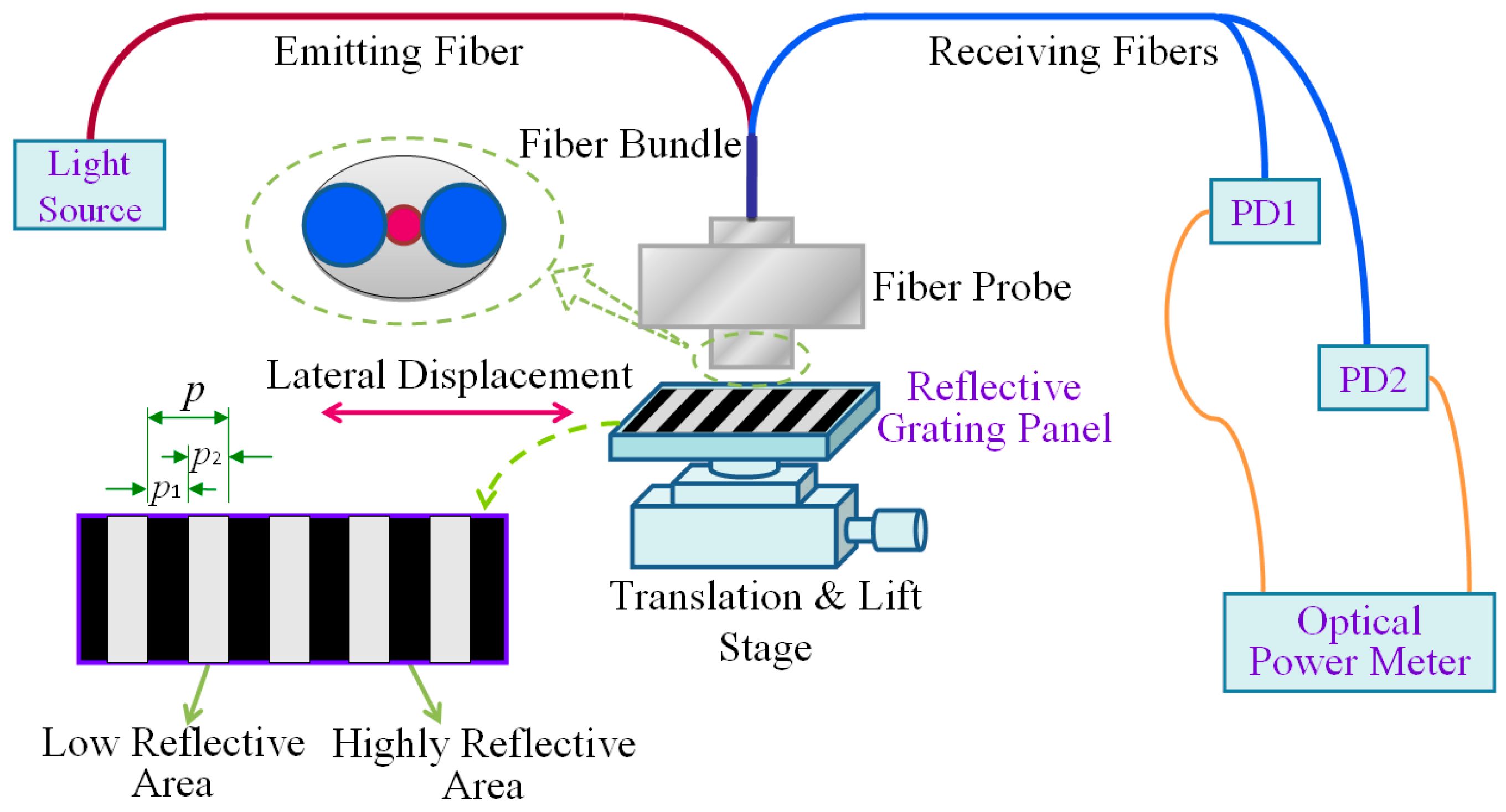
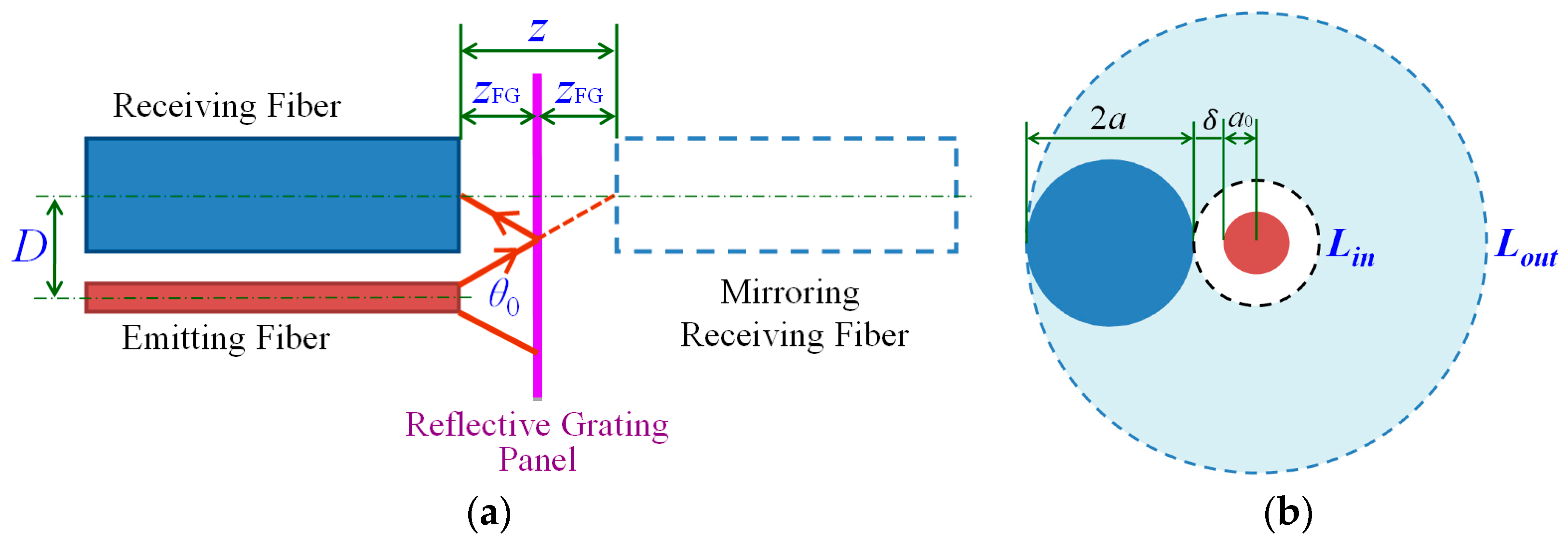

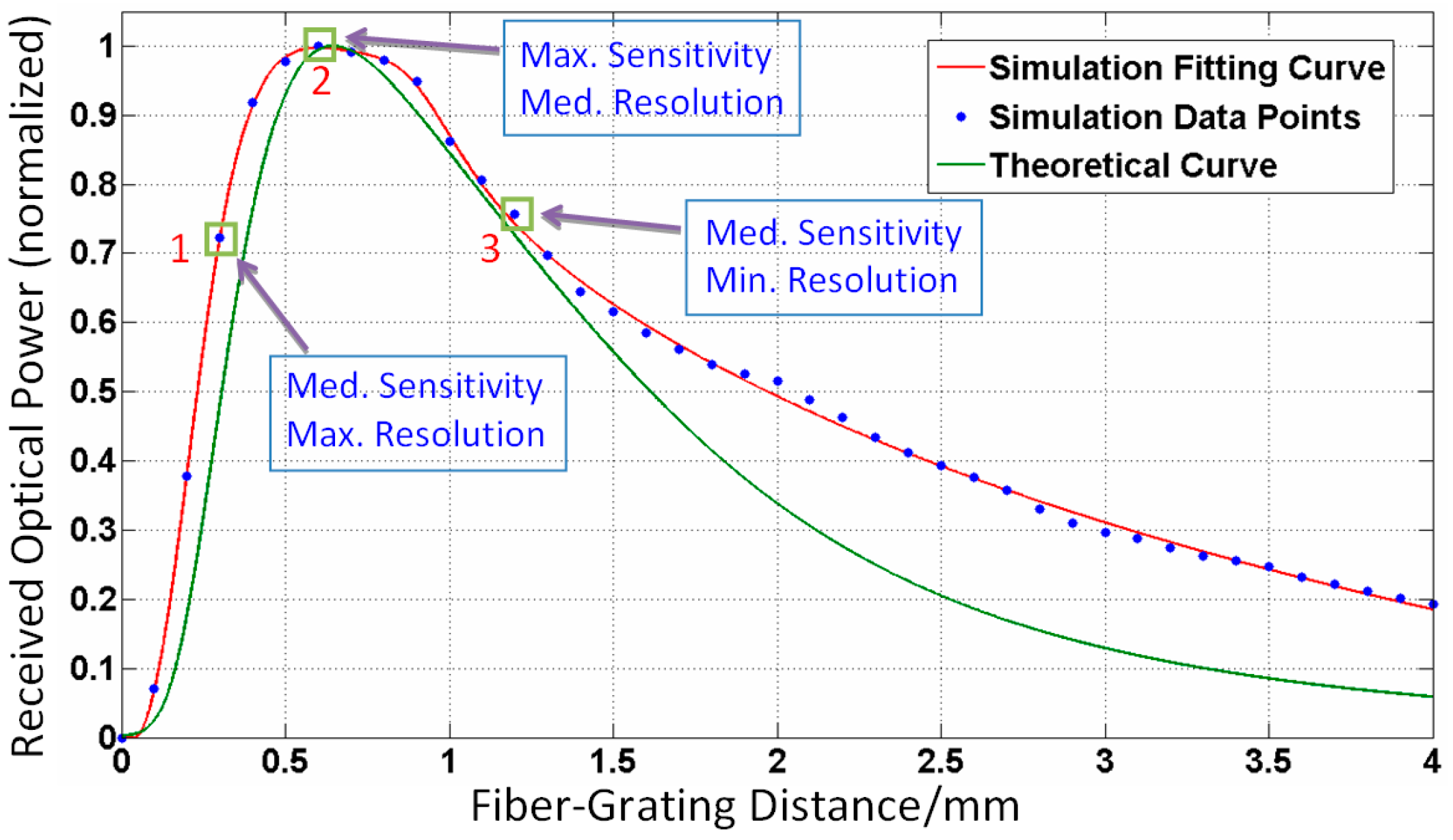
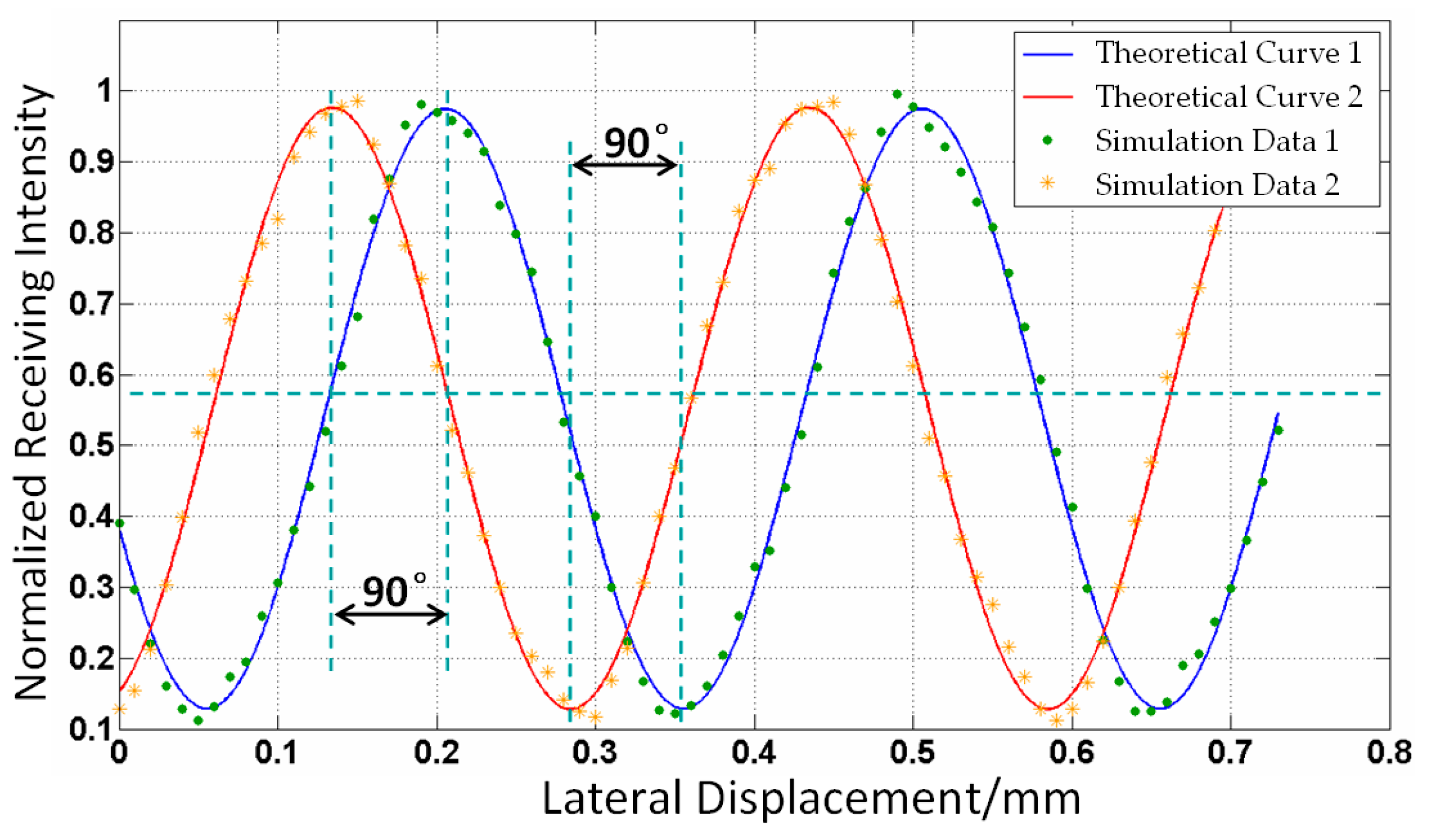

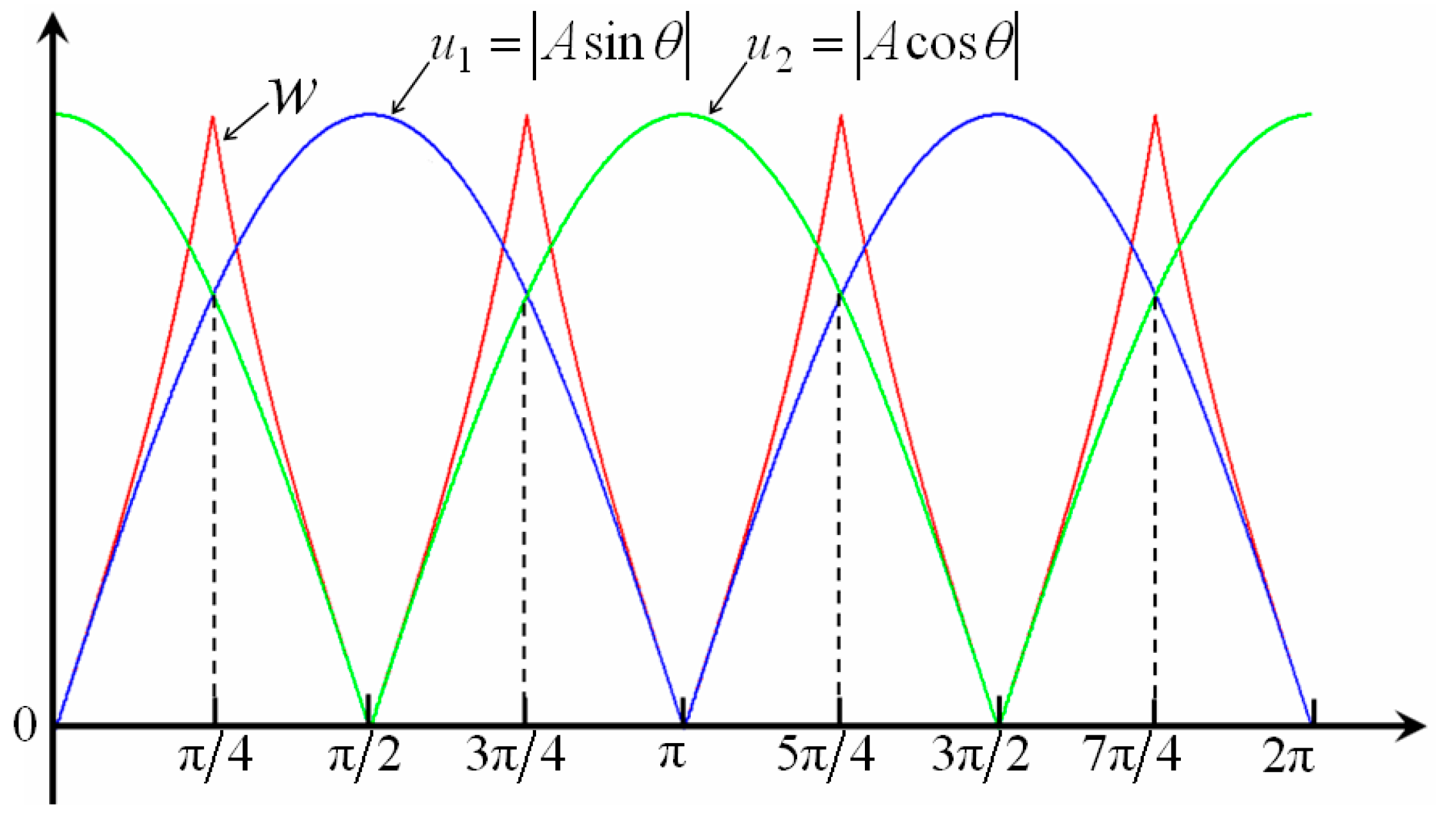
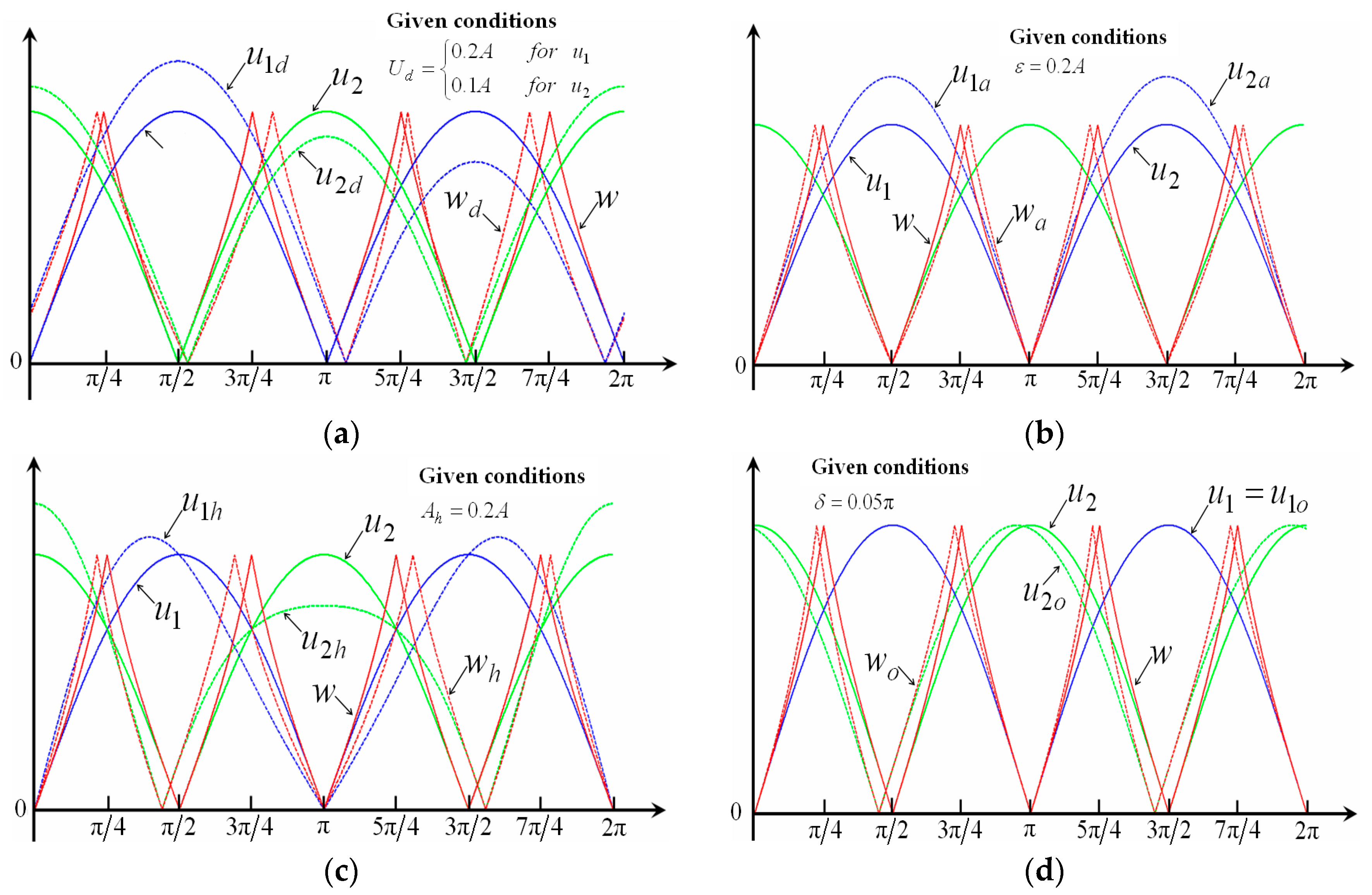


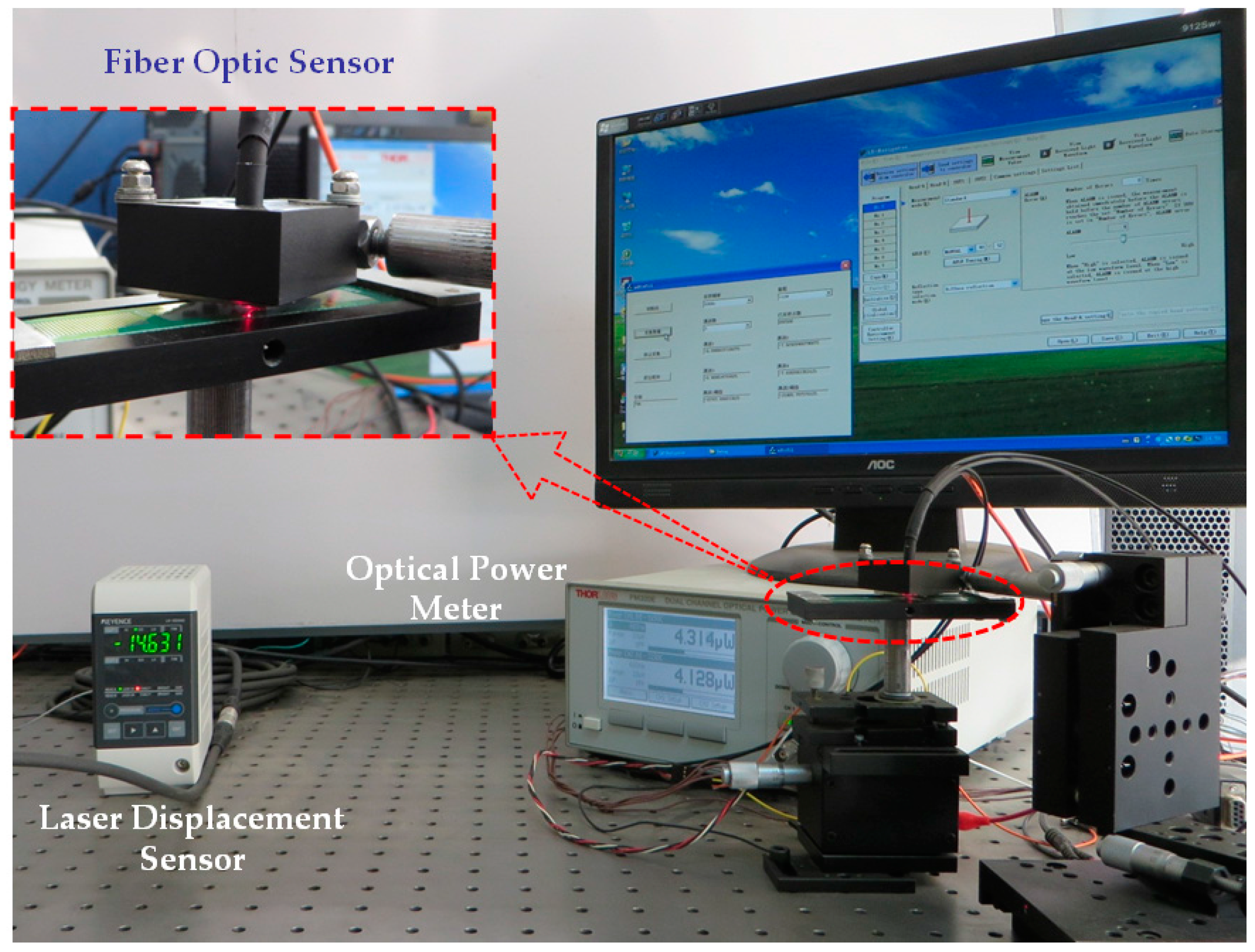

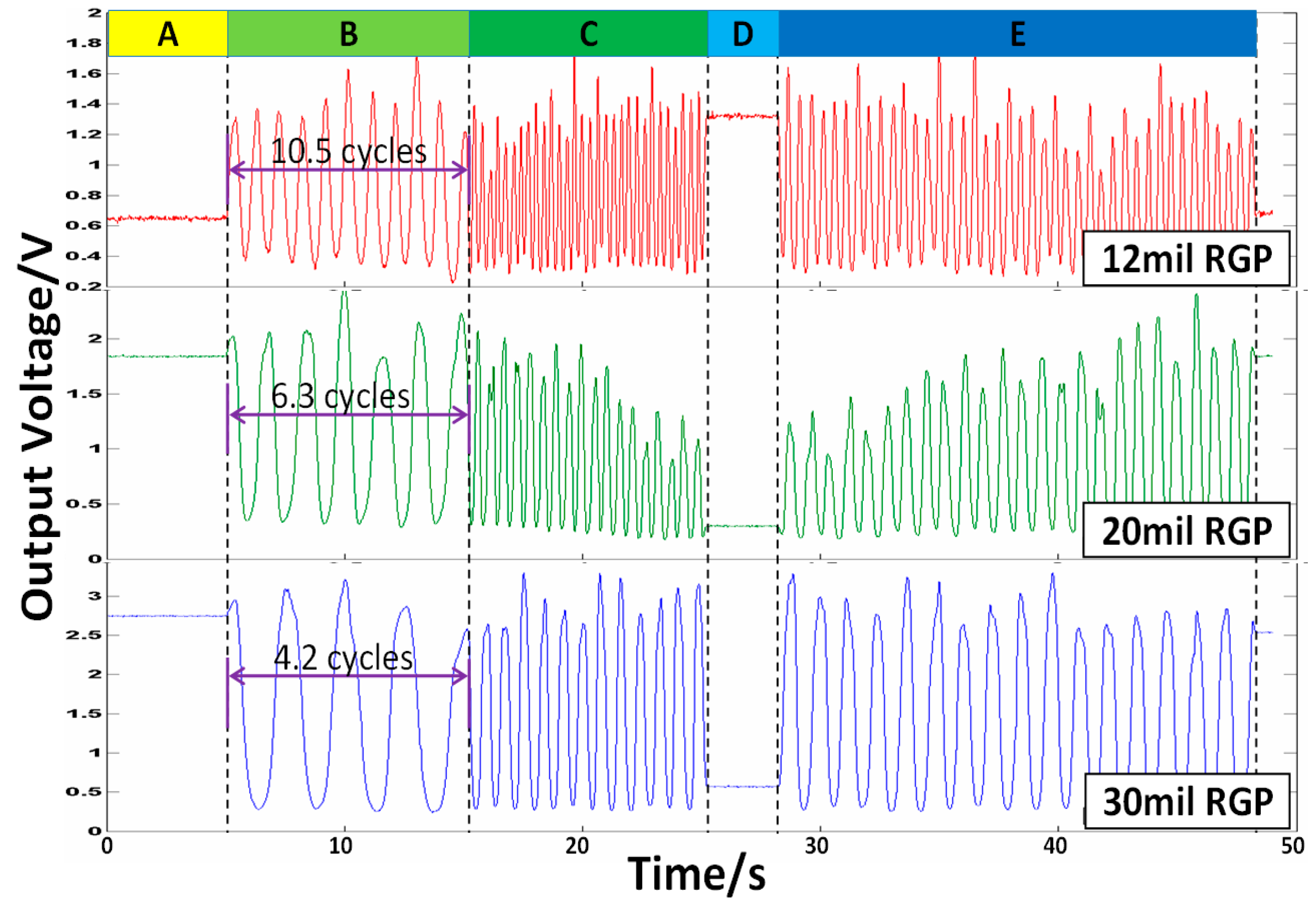
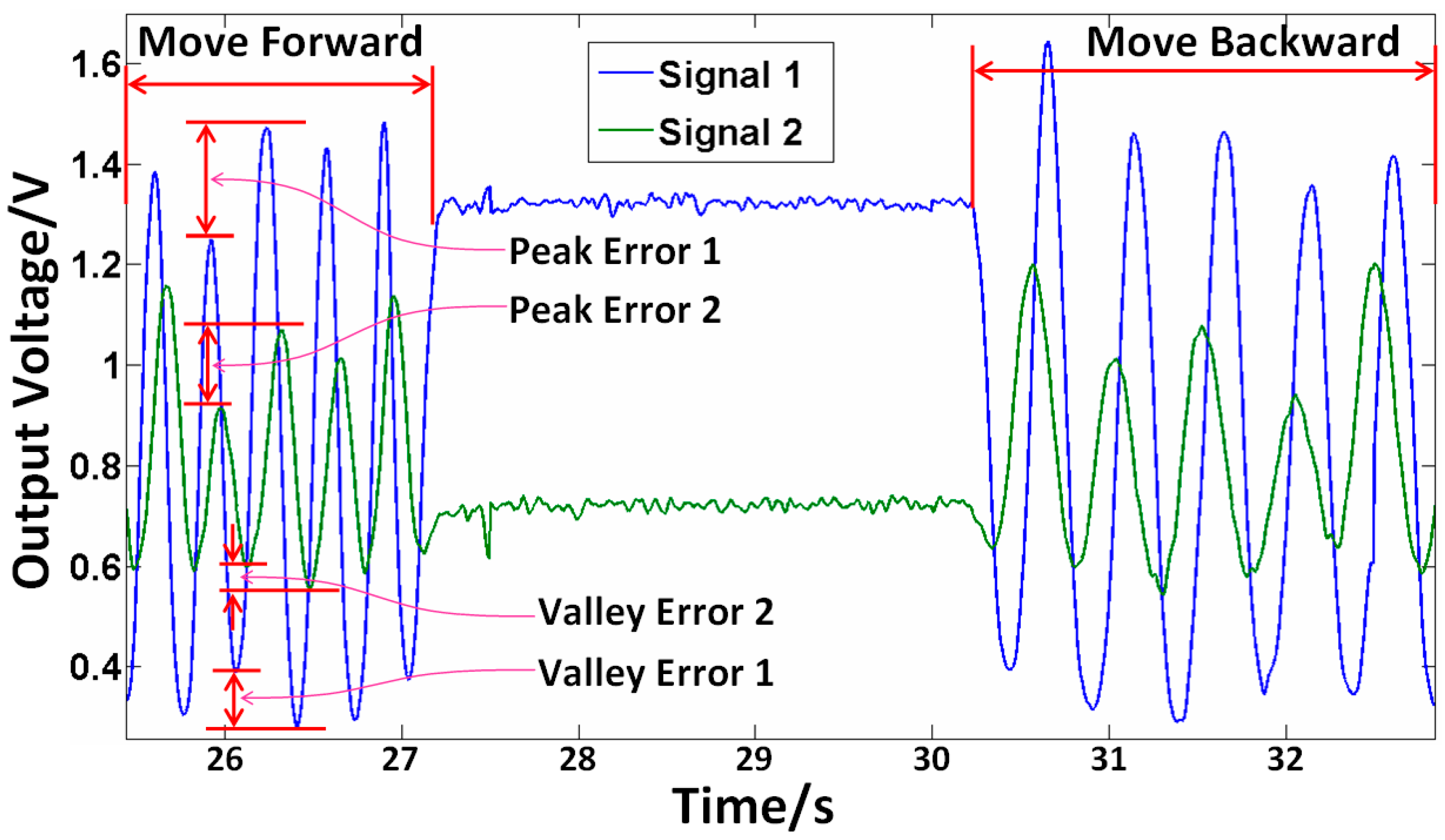
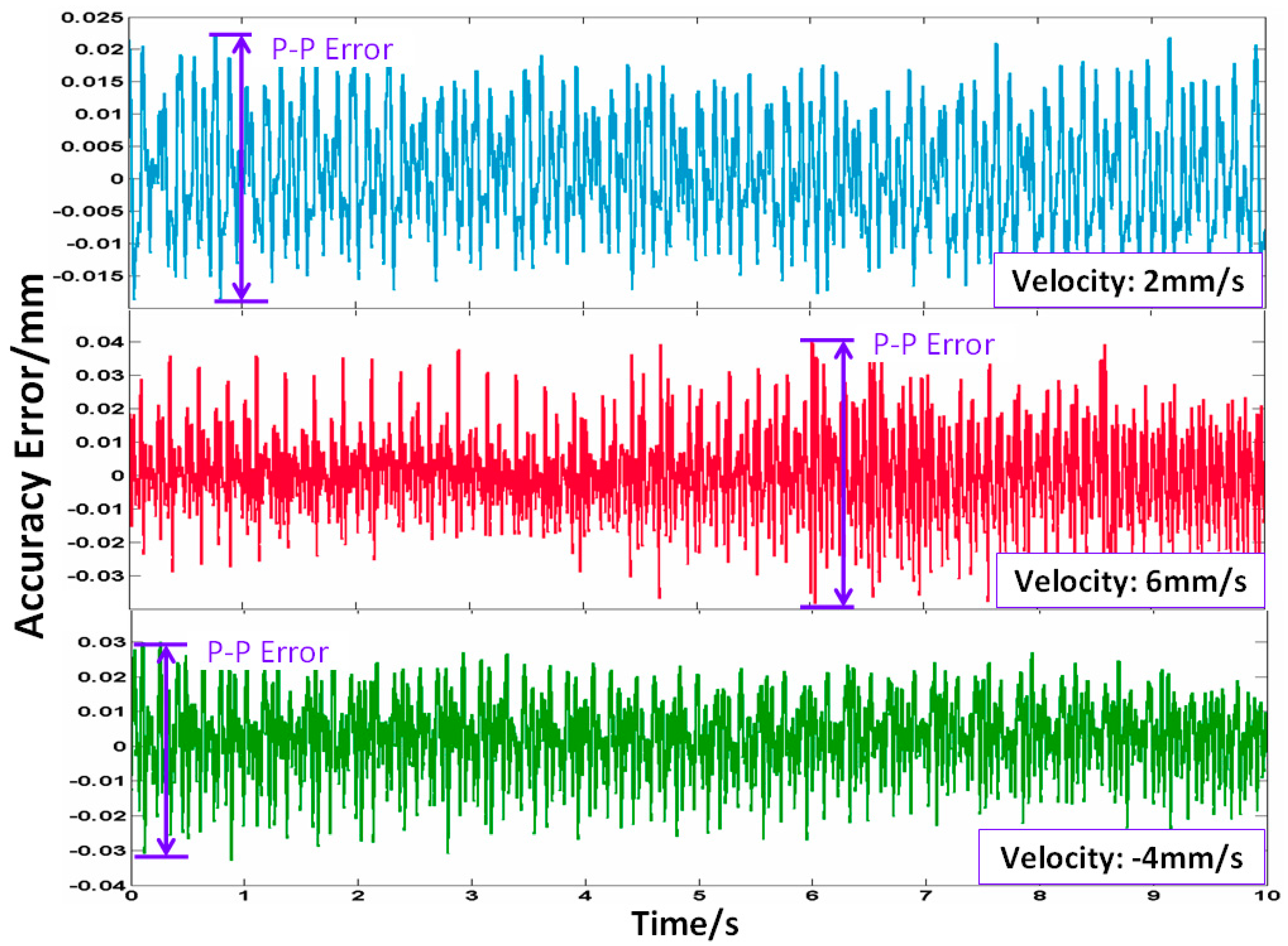
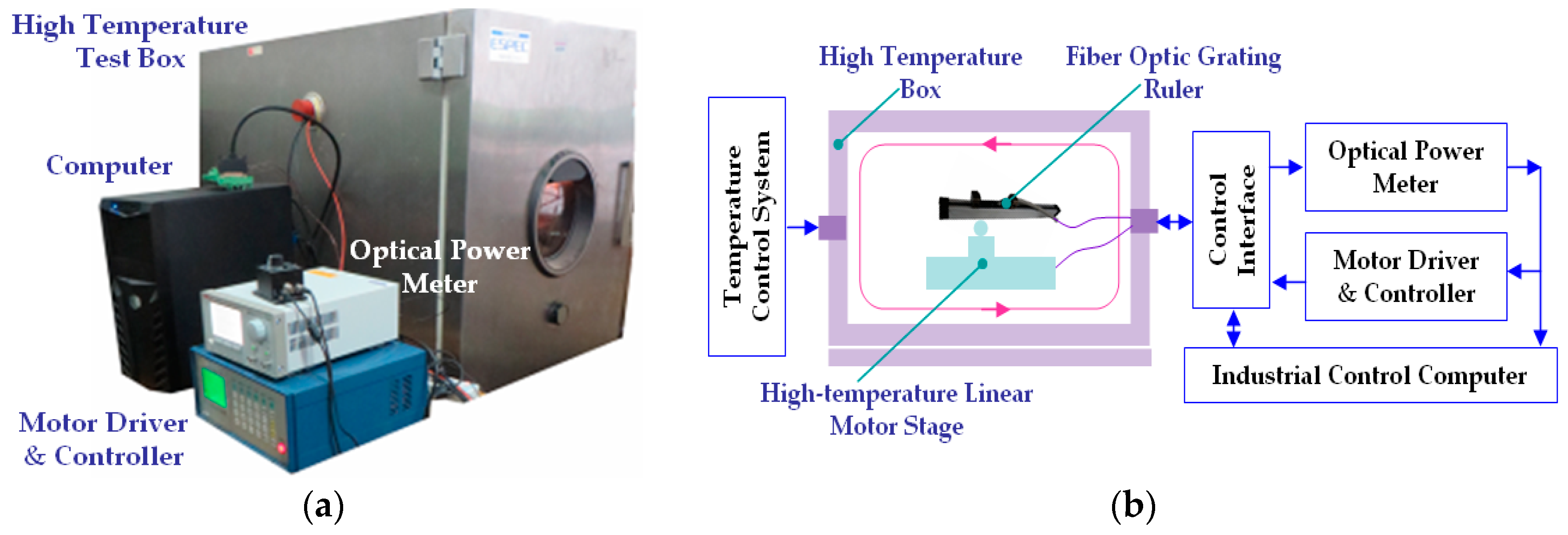
| Error Type | Accumulation Interval | Quantitative Requirements | Ensuring Measures for Precision Subdivision | Parameter Index | |
|---|---|---|---|---|---|
| Before Noise Processing | After Noise Processing | ||||
| DC signal | π/4 | Ud < 3.68% | Original signals are subtracted from average value | Ud = 0.1373A | Ud = 0.0304A |
| Amplitudes variation | π/2 | ε < ±11.8% | signal peak-to-peak amplitudes are used to correct the error | ε = 0.1884A | ε = 0.0086A |
| Harmonic component | π | Ah < 0.038A | FIR low-pass filtering | Ah = 0.0523A | Ah = 0.0351A |
| Non-orthogonal phase | π | δ < 0.0133π | Calculation of phase difference based on the position of signal peak | δ = 0.0741π | δ = 0.0286π |
| Pitch | Stage 1 Stage 2 Stage 3 | Velocity by LDS VL (µm·s−1) | Velocity by RFODS VR (µm·s−1) | Relative Measurement Error (VR − VL)/VL |
|---|---|---|---|---|
| Stage B | 315.8 | 316.9 | 0.348% | |
| 12 mil | Stage C | 936.0 | 937.8 | 0.192% |
| Stage E | −626.9 | −627.6 | 0.111% | |
| Stage B | 315.6 | 315.9 | 0.095% | |
| 20 mil | Stage C | 933.4 | 933.6 | 0.021% |
| Stage E | −628.2 | −628.9 | 0.111% | |
| Stage B | 314.4 | 313.7 | −0.223% | |
| 30 mil | Stage C | 935.9 | 938.7 | 0.299% |
| Stage E | −627.6 | −625.6 | −0.319% |
| Pitch (mil) | P-P of Noise Signal (V) | P-P of Effective Signal (V) | SNR |
|---|---|---|---|
| 12 | 0.050 | 1.191 | 21.655 |
| 20 | 0.026 | 1.709 | 65.731 |
| 30 | 0.021 | 2.885 | 137.381 |
| Temperature (°C) | V1 (μm/s) | V2 (μm/s) | V3 (μm/s) | α1 | α2 | α3 |
|---|---|---|---|---|---|---|
| −20 | 622.2 | 621.9 | 621.8 | −0.188% | −0.236% | −0.252% |
| −10 | 622.8 | 623.3 | 623.2 | −0.091% | −0.011% | −0.027% |
| 0 | 623.4 | 623.7 | 624.6 | 0.005% | 0.053% | 0.197% |
| 10 | 623.8 | 622.7 | 623.4 | 0.069% | −0.107% | 0.005% |
| 20 | 623.7 | 622.7 | 623.7 | 0.053% | −0.107% | 0.053% |
| 30 | 624.3 | 624.0 | 624.3 | 0.149% | 0.101% | 0.149% |
| 40 | 624.3 | 625.8 | 625.3 | 0.149% | 0.390% | 0.310% |
| 50 | 625.5 | 626.3 | 625.4 | 0.342% | 0.470% | 0.326% |
| 60 | 622.2 | 623.9 | 624.6 | −0.188% | 0.085% | 0.197% |
| 70 | 625.1 | 624.7 | 625.3 | 0.278% | 0.213% | 0.310% |
| 80 | 624.5 | 625.5 | 625.3 | 0.181% | 0.342% | 0.310% |
© 2016 by the authors; licensee MDPI, Basel, Switzerland. This article is an open access article distributed under the terms and conditions of the Creative Commons Attribution (CC-BY) license (http://creativecommons.org/licenses/by/4.0/).
Share and Cite
Li, Y.; Guan, K.; Hu, Z.; Chen, Y. An Optical Fiber Lateral Displacement Measurement Method and Experiments Based on Reflective Grating Panel. Sensors 2016, 16, 808. https://doi.org/10.3390/s16060808
Li Y, Guan K, Hu Z, Chen Y. An Optical Fiber Lateral Displacement Measurement Method and Experiments Based on Reflective Grating Panel. Sensors. 2016; 16(6):808. https://doi.org/10.3390/s16060808
Chicago/Turabian StyleLi, Yuhe, Kaisen Guan, Zhaohui Hu, and Yanxiang Chen. 2016. "An Optical Fiber Lateral Displacement Measurement Method and Experiments Based on Reflective Grating Panel" Sensors 16, no. 6: 808. https://doi.org/10.3390/s16060808





